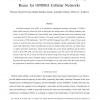Free Online Productivity Tools
i2Speak
i2Symbol
i2OCR
iTex2Img
iWeb2Print
iWeb2Shot
i2Type
iPdf2Split
iPdf2Merge
i2Bopomofo
i2Arabic
i2Style
i2Image
i2PDF
iLatex2Rtf
Sci2ools
CORR
2011
Springer
2011
Springer
Analytical Evaluation of Fractional Frequency Reuse for OFDMA Cellular Networks
Fractional frequency reuse (FFR) is an interference management technique well-suited to OFDMAbased cellular networks wherein the cells are partitioned into spatial regions with different frequency reuse factors. To date, FFR techniques have been typically been evaluated through system-level simulations using a hexagonal grid for the base station locations. This paper instead focuses on analytically evaluating the two main types of FFR deployments - Strict FFR and Soft Frequency Reuse (SFR) - using a Poisson point process to model the base station locations. The results are compared with the standard grid model and an actual urban deployment. Under reasonable special cases for modern cellular networks, our results reduce to simple closed-form expressions, which provide insight into system design guidelines and the relative merits of Strict FFR, SFR, universal reuse, and fixed frequency reuse. We observe that FFR provides an increase in the sum-rate as well as the well-known benefit o...
| Added | 26 Aug 2011 |
| Updated | 26 Aug 2011 |
| Type | Journal |
| Year | 2011 |
| Where | CORR |
| Authors | Thomas David Novlan, Radha Krishna Ganti, Arunabha Ghosh, Jeffrey G. Andrews |
Comments (0)

